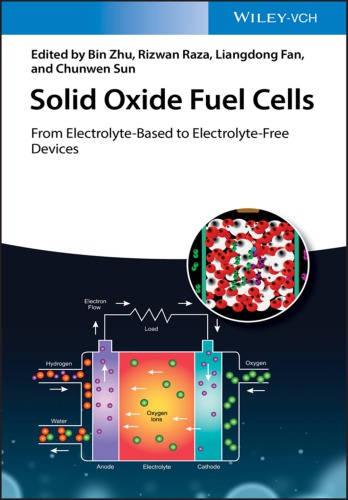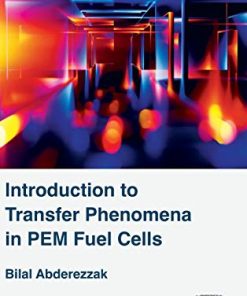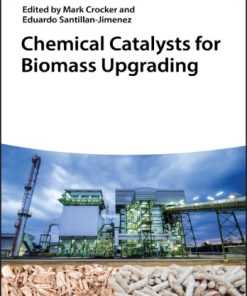(Ebook PDF) Solid Oxide Fuel Cells From Electrolyte Based to Electrolyte Free Devices 1st edition by Bin Zhu, Rizwan Raza, Liangdong Fan 3527812806 9783527812806 full chapters
$50.00 Original price was: $50.00.$25.00Current price is: $25.00.
Solid Oxide Fuel Cells: From Electrolyte-Based to Electrolyte-Free Devices 1st edition by Bin Zhu, Rizwan Raza, Liangdong Fan – Ebook PDF Instant Download/DeliveryISBN: 3527812806, 9783527812806
Full download Solid Oxide Fuel Cells: From Electrolyte-Based to Electrolyte-Free Devices 1st edition after payment.

Product details:
ISBN-10 : 3527812806
ISBN-13 : 9783527812806
Author : Bin Zhu, Rizwan Raza, Liangdong Fan
Presents innovative approaches towards affordable, highly efficient, and reliable sustainable energy systems Written by leading experts on the subject, this book provides not only a basic introduction and understanding of conventional fuel cell principle, but also an updated view of the most recent developments in this field. It focuses on the new energy conversion technologies based on both electrolyte and electrolyte-free fuel cells?from advanced novel ceria-based composite electrolyte low temperature solid oxide fuel cells to non-electrolyte fuel cells as advanced fuel-to-electricity conversion technology. Solid Oxide Fuel Cells: From Electrolyte-Based to Electrolyte-Free Devices is divided into three parts.
Solid Oxide Fuel Cells: From Electrolyte-Based to Electrolyte-Free Devices 1st Table of contents:
Part I: Solid Oxide Fuel Cell with Ionic Conducting Electrolyte
1 Introduction
1.1 An Introduction to the Principles of Fuel Cells
1.2 Materials and Technologies
1.3 New Electrolyte Developments on LTSOFC
1.4 Beyond the State of the Art: The Electrolyte-Free Fuel Cell (EFFC)
1.5 Beyond the SOFC
References
Note
2 Solid-State Electrolytes for SOFC
2.1 Introduction
2.2 Single-Phase SOFC Electrolytes
2.3 Ion Conduction/Transportation in Electrolytes
2.4 Composite Electrolytes
2.5 NANOCOFC and Material Design Principle
2.6 Concluding Remarks
Acknowledgments
References
Note
3 Cathodes for Solid Oxide Fuel Cell
3.1 Introduction
3.2 Overview of Cathode Reaction Mechanism
3.3 Development of Cathode Materials
3.4 Microstructure Optimization of Cathode Materials
3.5 Summary
References
Note
4 Anodes for Solid Oxide Fuel Cell
4.1 Introduction
4.2 Overview of Anode Reaction Mechanism
4.3 Development of Anode Materials
4.4 Development of Kinetics, Reaction Mechanism, and Model of the Anode
4.5 Summary and Outlook
Acknowledgments
References
Note
5 Design and Development of SOFC Stacks
5.1 Introduction
5.2 Change of Cell Output Performance Under 2D Interface Contact
5.3 Control Design of Transition from 2D to 3D Interface Contact and Their Quantitative Contribution Differentiation
5.4 Conclusions
References
Note
Part II: Electrolyte-Free Fuel Cells: Materials, Technologies, and Working Principles
6 Electrolyte-Free SOFCs: Materials, Technologies, and Working Principles
6.1 Concept of the Electrolyte-Free Fuel Cell
6.2 SLFC Using the Ionic Conductor-based Electrolyte
6.3 Developments on Advanced SLFC
6.4 From SLFCs to Semiconductor–Ionic Fuel Cells (SIFCs)
6.5 The SLFC Working Principle
6.6 Remarks
Acknowledgments
References
Note
7 Ceria Fluorite Electrolytes from Ionic to Mixed Electronic and Ionic Membranes
7.1 Introduction
7.2 Doped Ceria as the Electrolyte for Intermediate Temperature SOFCs
7.3 Surface Doping for Low Temperature SOFCs
7.4 Non-doped Ceria for Advanced Low Temperature SOFCs
References
Note
8 Charge Transfer in Oxide Solid Fuel Cells
8.1 Oxygen Diffusion in Perovskite Oxides
8.2 Proton Diffusion in Perovskite-Type Oxides
8.3 Enhanced Ion Conductivity in Oxide Heterostructures
8.4 Summary
Acknowledgments
References
Note
9 Material Development II: Natural Material-based Composites for Electrolyte Layer-free Fuel Cells
9.1 Introduction
9.2 Industrial-grade Rare Earth for EFFCs
9.3 Natural Hematite for EFFCs
9.4 Natural CuFe Oxide Minerals for EFFCs
9.5 Bio-derived Calcite for EFFC
References
Note
10 Charge Transfer, Transportation, and Simulation
10.1 Physical Aspects
10.2 Electrochemical Aspects
10.3 Ionic Conduction Enhancement in Heterostructure Composites
10.4 Charge Transportation Mechanism and Coupling Effects
10.5 Surface and Interfacial State-Induced Superionic Conduction and Transportation
10.6 Ionic Transport Number Measurements
10.7 Determination of Electron and Ionic Conductivities in EFFCs
10.8 EIS Analysis
10.9 Semiconductor Band Effects on the Ionic Conduction Device Performance
10.10 Simulations
Acknowledgments
References
Note
11 Electrolyte-Free Fuel Cell: Principles and Crosslink Research
11.1 Introduction
11.2 Fundamental Considerations of Fuel Cell Semiconductor Electrochemistry
11.3 Working Principle of Semiconductor-Based Fuel Cells and Crossing Link Sciences
11.4 Extending Applications by Coupling Devices
11.5 Final Remarks
Acknowledgments
References
Notes
Part III: Fuel Cells: From Technology to Applications
12 Scaling Up Materials and Technology for SLFC
12.1 Single-Layer Fuel Cell (SLFC) Engineering Materials
12.2 Scaling Up Single-Layer Fuel Cell Devices: Tape Casting and Hot Pressing
12.3 Scaling Up Single-Layer Fuel Cell Devices: Thermal Spray Coating Technology
12.4 Short Stack
12.5 Tests and Evaluations
12.6 Durability Testing
12.7 A Case Study for the Cell Degradation Mechanism
12.8 Continuous Efforts and Future Developments
12.9 Concluding Remarks
References
Note
13 Planar SOFC Stack Design and Development
13.1 Internal Manifold and External Manifold
13.2 Interface Between an Interconnect Plate and a Single Cell
13.3 Antioxidation Coating of the Interconnect Plate
13.4 Design the Flow Field of Interconnect Plate
13.5 The Importance of Sealing
13.6 The Life of the Stack: The Chemical Problems on the Interface
13.7 Toward Market Products
13.8 Concluding Remarks
References
Note
14 Energy System Integration and Future Perspectives
14.1 Solar Cell and Fuel Cell
14.2 Fuel Cell–Solar Cell Integration
14.3 Solar Electrolysis–Fuel Cell Integration
14.4 Fuel Cell–Biomass Integration
14.5 The Fuel Cell System Modeling Using Biogas
14.6 The Fuel Cell System Efficiency (Heating and Electrical)
14.7 Integrated New Clean Energy System
14.8 Summary
People also search for Solid Oxide Fuel Cells: From Electrolyte-Based to Electrolyte-Free Devices 1st:
what are solid oxide fuel cells used for
bloom energy solid oxide fuel cells
how solid oxide fuel cells work
intermediate temperature solid oxide fuel cells
advantages of solid oxide fuel cells
Tags:
Solid Oxide,Fuel Cells,Electrolyte Based,Electrolyte Free Devices,Bin Zhu,Rizwan Raza,Liangdong Fan
You may also like…
Science (General)
Solid Oxide Fuel Cells: From Electrolyte-Based to Electrolyte-Free Devices 1st Edition Bin Zhu
Engineering - Energy & Power Resources
Introduction to Transfer Phenomena in PEM Fuel Cells 1st Edition
Engineering
Engineering
Fuel Cells and Hydrogen: From Fundamentals to Applied Research 1st edition Viktor Hacker
Engineering
PEM Fuel Cells: Fundamentals, Advanced Technologies, and Practical Application 1st edition
Science (General)












